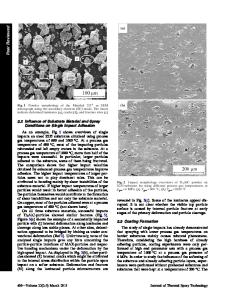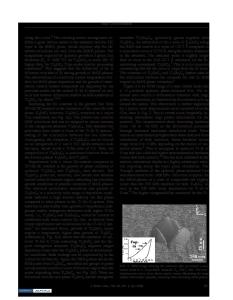Preparation of Ti 2 AlC and Ti 3 AlC 2 MAX Phases by Self-Propagating High-Temperature Synthesis with the Reduction Stag
- PDF / 490,906 Bytes
- 5 Pages / 612 x 792 pts (letter) Page_size
- 105 Downloads / 373 Views
ROPAGATING HIGH-TEMPERATURE SYNTHESIS
Preparation of Ti2AlC and Ti3AlC2 MAX Phases by Self-Propagating High-Temperature Synthesis with the Reduction Stage V. I. Vershinnikova, * and D. Yu. Kovaleva, ** aInstitute
of Structural Macrokinetics, Russian Academy of Sciences, Chernogolovka, Moscow oblast, 142432 Russia *e-mail: [email protected] **e-mail: [email protected] Received November 20, 2019; revised December 11, 2019; accepted December 16, 2019
Abstract—This work is devoted to the preparation of powders of Ti2AlC and Ti3AlC2 MAX phases by selfpropagating high-temperature synthesis (SHS) using the magnesium-thermal reduction from oxide feedstock. Oxide TiO2 is used as the titanium source, and magnesium is used as the reducing agent. Purification with the removal of magnesium oxide is performed in diluted hydrochloric acid at a temperature of 70°C and concentration of 1 : 3. The target product yield with the magnesium-thermal reduction is 35–40%. It is revealed that the synthesis product with the stoichiometric component ratio after chemical leaching in hydrochloric acid consists of Ti2AlC, MgAl2O4, and TiC. The formation of spinel MgAl2O4 is associated with the deficiency of the magnesium reducing agent in the charge; herewith, aluminum partially enters the reduction reaction of titanium from its oxide with the formation of Al2O3. This leads to the formation of spinel MgO ⋅ Al2O3. An increase in the content of excess magnesium in the charge from 20 to 30 wt % conditions the complete reduction of titanium from its oxide by magnesium with the formation of the Ti2AlC MAX phase and titanium carbide. A decrease of 10 wt % in the carbon content causes a decrease in the titanium carbide fraction to 4%. The product, containing Ti3AlC2 and Ti2AlC MAX phases, as well as TiC, is formed at an excess soot content from 20 to 35%, and the Ti3AlC2 weight fraction increases from 86 to 89%, respectively. These powders comprise agglomerates (87% of them are smaller than 65 μm) consisting of thin plates of MAX phases 70–100 nm in thickness. Keywords: Ti3AlC2 and Ti2AlC MAX phases, self-propagating high-temperature synthesis, powders, magnesium-thermal reduction DOI: 10.3103/S1067821220050156
INTRODUCTION The development of new structural and functional materials is an important problem of materials science. Currently, and increase in the number of publications and patents devoted to the synthesis and investigation of the properties of MAX phases is noted. These phases are ternary compounds with hexagonal close packing and formula Mn + 1AXn, where M is the transition d metal, A is the element from Groups IIIA–VI of the periodic table, X is carbon or nitrogen, and n = 1– 5 [1–4]. These compounds have a layered crystalline structure in which carbide or nitride blocks [Mn + 1Xn] are separated by monolayers of atoms of Group IIIA and IVA elements. Lamination at the crystalline structure level leads to the nanolaminated grain structure with a layer thickness of up to tens of nanometers. The layered structure a priori provides high mechani
Data Loading...











